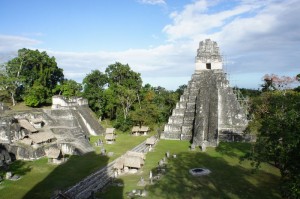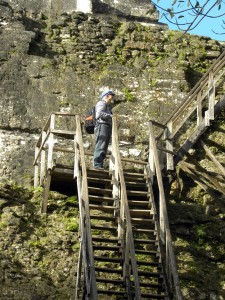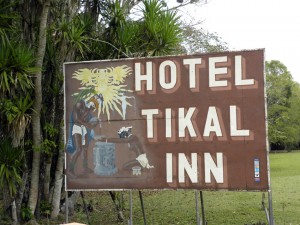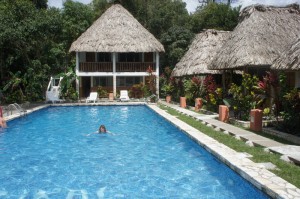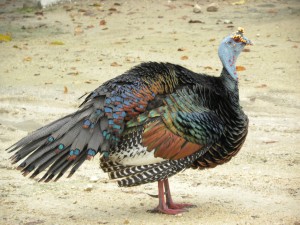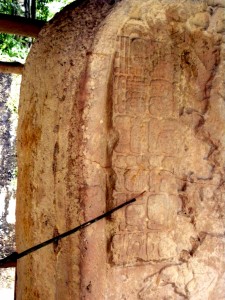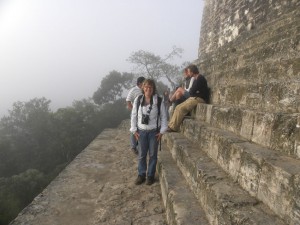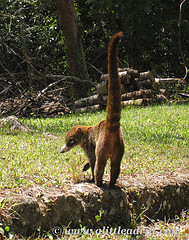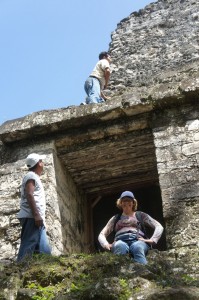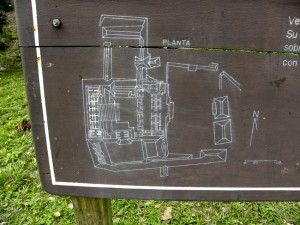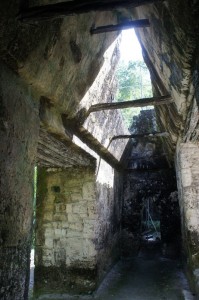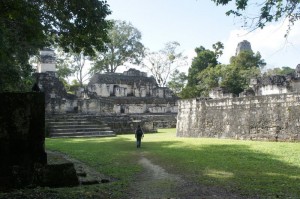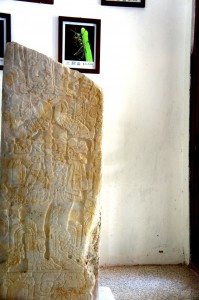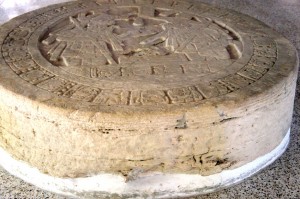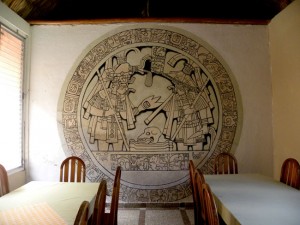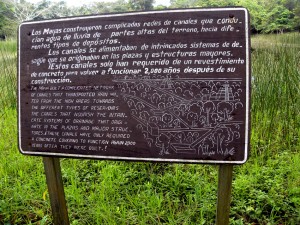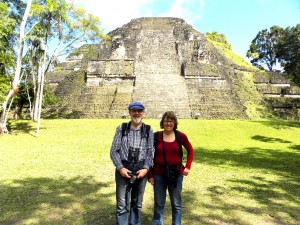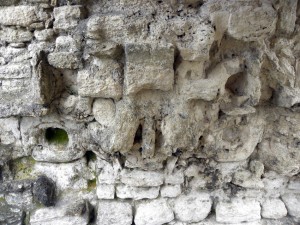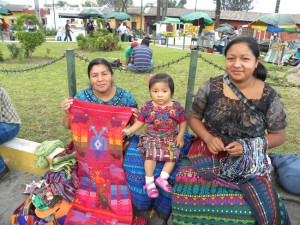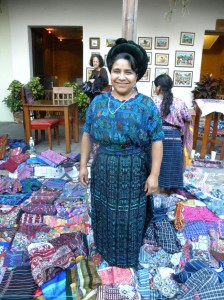Tikal A Few Thoughts by a Non Specialist
Tikal. Thousands of unexcavated sites, but Temple I, the icon of Guatemala, does not disappoint. A “mortuary pyramid” not a temple, it is elegant, grand, and spectacular. Pretty much invisible today is the seated sculpture of Jasaw Chan K’awiil on the top.( 734AD). It was first discovered in 1882 by Alfred Maudsley. The king was buried underneath with an enormous collection of jade, mirrors, pearls ceramics, and other objects including intricately incised bones. Today we can climb wooden stairs up some of the structures ( this is Temple II) , not the challenging steep stone steps.
Tikal, one of the great mesoamerican sites in Central America, still emerges from deep jungle in the lowlands of Northern Guatemala. It is at the center of a large biosphere, but actually a lot has been clear cut (Various Europeans starting in the 1890s : the British logged for mahogany. The sites emerged as the logging occurred.) This jungle biosphere is the home to 60,000 people. Five days walk through the jungle would have taken us to El Mirador, another huge site. Next time!
We stayed at the Tikal Inn at the site, an amazingly beautiful little hotel, with a swimming pool, and comfortable rooms. We felt really decadent, compared to previous visitors as recently as the 1990s, while the Civil War was still going on and the government was not able to have the luxury of catering to tourists. Although we had electricity for only two hours, we never missed it.
Right at the lodge were all sorts of beautiful birds, like this oscellated turkey,and it was easy to walk to the site.
We took several tours with guides,all of them well-informed on various topics, history, geology, ecology, birds, engineering, religion, dating systems. Here is a guide pointing out the dating system on an onsite stele.
The most exciting tour was getting up at 4am to walk through the darkness and hear the jungle awaken from the top of Temple IV. It started with a single howler monkey, then a conversation between them, then the birds began, first a single one and then a chorus of many different birdsongs. I am a novice birder, but they were whistle like, sharply repeated, and some faster some slower. In the background the howlers continued, like the bass in an orchestra. The original music. As the mist lifted, the monkeys subsided and the birds got more varied and louder.According to one expert guide, there are 400 species of birds here, including 65 migrating birds. I saw about 20 including the Toucan, known as a flying banana because of his big yellow beak and the Red Lored Parrot.
Apparently quite recently the howler monkeys were almost extinct, according to a guidebook written in the late 1980s.
The small coatimundi was everywhere, an anteater like small creature which had the run of the site as soon as the people left.( I think they may be overbreeding).
We also saw leafcutter ants who have an extraordinary division of labor.
By far the best experience was spending a day in the jungle exploring, Temple VI: I was helped up by a steel armed worker for the National Park. Above another Park employee is taking a picture of the big rain god mask on the upper part of the temple.
Then Complex G, an amazing complex of buildings with lots of corbelled arches.
and the Central Acropolis where one of the excavators, Teobert Maler, set himself up from 1895 – 1904. It is a multi courted series of buildings on different levels and with many plans. Fascinating to explore. This photograph doesn’t tell you much.
The central area of Tikal has about 200 stone monuments including stele and altars. Most of them are now in the two on site museums, one called the Ceramic Museum, the other the Stone Museum, although the Ceramic museum also has Stele including the most famous no 31. This photograph is pretty impossible to see
(taken illegally), but it represents the ruler Siyaj Chan K’awiil ( Sky Born K’awiil) 411- 456 AD flanked by portraits of his father Yax Nuun Ayiin with enormously complex symbolic regalia. and a representation of him in the headress emerging from a split in the sky.
Altar no 5 was in the Stone Museum, and a painting of it was on the wall of our hotel dining room. Two rulers Jasaw Chan K’awiil and another leader are conducting an exhumation ritual with the bones of a high ranking lady between them.
An amazing item in the Stone Museum, aside from the many stelae, was a wooden lintel from Temple 4 ( I think it is a replica). There were a lot of wooden lintels on these temples, many of which have been taken off to museums in Europe, with amazingly intricate representations of various rulers. Many more objects from burials are also to be found in the National Museum of Archaeology and Ethnology (the old guidebook I have written by William Coe of the University of Pennsylvania mentions several jade pieces stolen from the Tikal museum in 1981).
Apparently the site was occupied and temples and other structures were built over a period of 1100 years. Starting in the Preclassic which is about 600 BC, then a Classic Period 250-900 and the Post Classic. Most of the structures date from 550 – 900, the so called Late Classic, but underneath the visible structures are layers of earlier buildings, as well as burials. Under Temple I the burial had 8 kilos of jade objects.
The construction of Temple I appeared in a model at the Popol Vuh museum.
Leverage and ropes were used to move the colossal blocks (exactly the same system was used for the John T. Williams commemorative totem pole raised in Seattle Center in 2012.) Who were the laborers? Were they devout, were they slaves? Who were the designers, the engineers? It was evident as we visited the site, that the Maya were brilliant engineers, particularly with stone buildings and organizing water supplies. This sign suggested the complexity of underground tunnels used for transporting water.
They separated fresh water supplies in various categories.
The technique of making quick lime to hold the stones together was also explained, difficult and time consuming. We saw kilns that survived as well as underground storage areas for chocolate, maize and nuts. Human waste was used as fertilizer.
The so called “Mundo Perdido” had several amazing structures. East of its main pyramid are three smaller structures that serve to mark the point on the horizon where the sun rises on the solstices and equinoxes. Behind us is one of the pyramids that show the influence of Teotihuacan design.
The surviving (all but 4 destroyed by the Spaniards) codices from the Maya contain predictions and knowledge about planting, weather, and cyclical patterns that relate to the purpose of the “Mundo Perdido.”
We tried to imagine how Tikal would have looked, swarming with people and the temples brightly painted.The sculptures showed clear evidence of the arrival of people from Teotihuacan in the design and the sculpture (and representations of Tlaloc, the rain god, who is all over Teotihuacan).
They arrived in 389 AD according to new understanding of the dating system. Thus much of what we see at Tikal is a blend of Mexicana and Maya styles. And of course we are looking at the culture of the elites. There were many ordinary houses, but they have all disappeared. Apparently they dispersed into small communities in the jungle when the large city complex fell, but today there is still an active sacred alter near Temple I in the Central Plaza.
One theory of the decline of Tikal as a grand empire center is that there just wasn’t enough land to cultivate or water to support the population as it expanded. But the decline was also probably because of warfare among different Maya, just as today, we are squandering our resources on warfare and despoiling the environment. But what will be left of our culture in a thousand years ? Maybe piles of rusted military equipment that accidentally survives.
According to one guide (on Temple IV at dawn) these temples had small chambers in which elites ate magic mushrooms and snorted various leaves that made them very high a lot of the time.
And of course the Maya survive until today, despite all the efforts to obliterate them and ongoing taking of their land (see previous post). The elegance and dignity of the people is remarkable given what they have been through over the centuries. According to the National Museum of Archeology brochure there are 24 different ethnic Maya groups in Guatemala today. But it declared “Guatemaltecos somos todos.” Creativity wins!
This entry was posted on May 3, 2012 and is filed under Guatemala.

